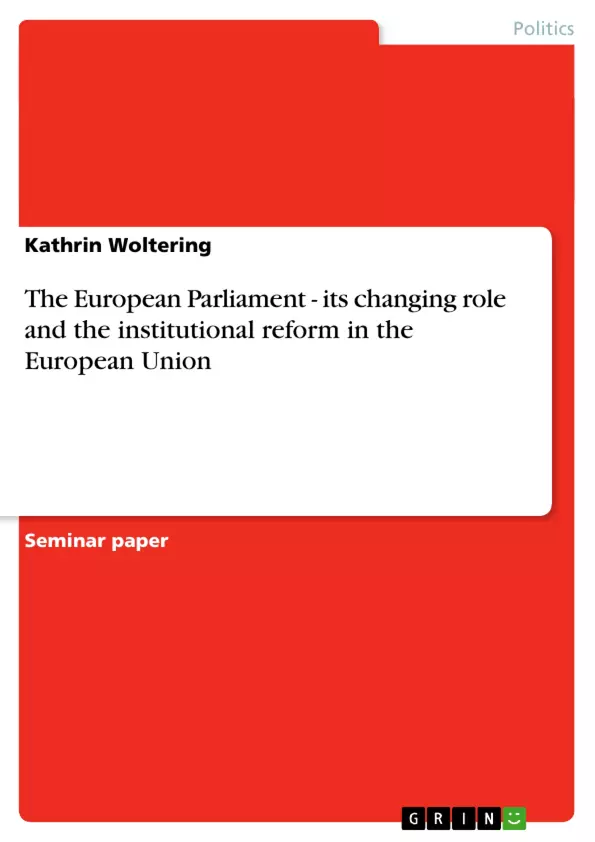Since 1979 the European Community resp. nowadays the European Union is provided
with a parliament. From this time on there have been a lot of vehement and
controversial discussions mainly concerning the role of this European Parliament
(EP) and its legitimacy. Keeping this in mind, before lighting up the details of the institutional
reform process - mainly focussing the recent Convention (-Debate) -, I will
present the basic principles of constitution, tasks and functioning of the European
Parliament.
As said in the Treaty of Rome from 1957 the European Parliament represents the
people of the Member States of the European Community. Thus “375 million European
citizens in 15 countries are now involved in the process of European Integration
through their 626 representatives in the European Parliament1”
(http://www.europarl.eu.int/presentation/default_en.htm, 30.04.03). In its constituting
session on March 21, 1958 the general assembly was named “European Parliament”.
Until 1979, every five years the European Parliament is build by direct universal elections.
The main tasks of the EP are consultation and supervision; it is also featured
with the right to sue to the Court of Justice. The seat of the plenum of the EP is in
Strasbourg – supplementary the Committees hold their meetings in Brussels, the
General Secretariat remained in Luxembourg.
The tasks of the EP are composed of the general legislative power, the constitutional
right to decide on the budget, the right of control and interaction. To explain this aspects
more detailed:
· The general legislative power: The Parliament grew from a kind of forum to a
shaping actor (cp. Schmuck 1994: p.22). By dint of the so called isoglucose
case the European Parliament was given a “very useful delaying power” (Nugent
2001:p.207). [...]
1 Germany: 99; Great Britain, France and Italy: 87 each; Spain: 64; the Netherlands: 31; Belgium,
Greece, Portugal: 25 each; Sweden: 22; Austria: 21; Denmark and Finland: 16 each; Ireland: 15; Luxembourg:
5 (Art. 190 ECT).
Inhaltsverzeichnis (Table of Contents)
- The Parliament of the European Union, its development and structure
- The Convention and its proposal - a new option for the institutional reform of the European Parliament?
- A proposal of the European Commission - what are the interests of the leading resp. “governing” Institution within the European Union?
- The European Parliament in the recent discussion
- Conclusion
Zielsetzung und Themenschwerpunkte (Objectives and Key Themes)
This paper examines the evolving role of the European Parliament and the ongoing discussion surrounding institutional reform within the European Union. It aims to provide a comprehensive analysis of the European Parliament's historical development, its current structure, and its potential for future growth and influence.
- The development and structure of the European Parliament
- The role of the European Parliament in the institutional reform process
- The interests of various institutions within the European Union
- The challenges and opportunities for the European Parliament in the future
- The impact of the European Parliament on European integration
Zusammenfassung der Kapitel (Chapter Summaries)
The first chapter delves into the origins and structure of the European Parliament, highlighting its development from a consultative body to a more influential legislative actor. The chapter discusses the Parliament's main tasks, including legislative power, budget control, and the right of control, and explores the complexities of its electoral procedure and the representation of different member states.
The second chapter examines the proposed institutional reforms of the European Parliament, focusing on the Convention's preliminary proposals and the European Commission's December 2002 paper. It analyzes the potential impact of these proposals on the Parliament's role and power within the European Union.
Schlüsselwörter (Keywords)
The key terms and concepts explored in this paper include the European Parliament, institutional reform, European Union, legislative power, budget control, electoral procedure, Convention, European Commission, and representation.
- Quote paper
- Kathrin Woltering (Author), 2002, The European Parliament - its changing role and the institutional reform in the European Union, Munich, GRIN Verlag, https://www.grin.com/document/23235



